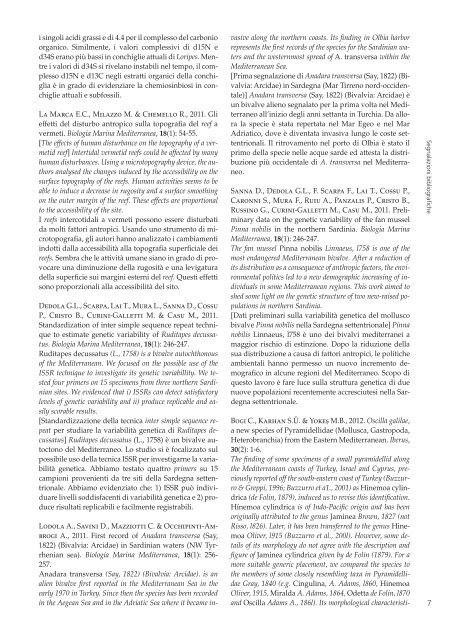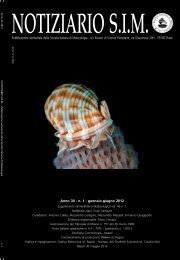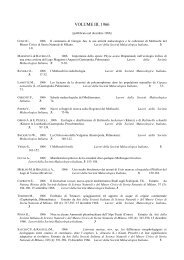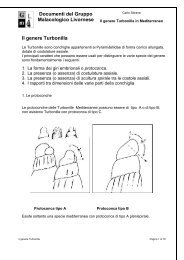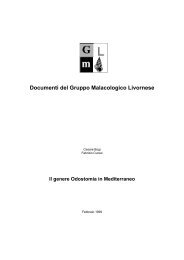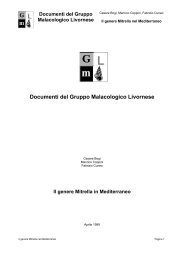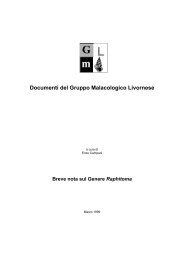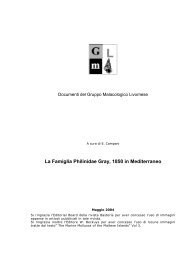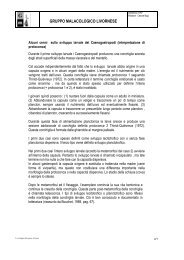scarica il Notiziario S.I.M. - Società Italiana di Malacologia
scarica il Notiziario S.I.M. - Società Italiana di Malacologia
scarica il Notiziario S.I.M. - Società Italiana di Malacologia
Create successful ePaper yourself
Turn your PDF publications into a flip-book with our unique Google optimized e-Paper software.
i singoli aci<strong>di</strong> grassi e <strong>di</strong> 4.4 per <strong>il</strong> complesso del carbonio<br />
organico. Sim<strong>il</strong>mente, i valori complessivi <strong>di</strong> d15N e<br />
d34S erano più bassi in conchiglie attuali <strong>di</strong> Loripes. Mentre<br />
i valori <strong>di</strong> d34S si rivelano instab<strong>il</strong>i nel tempo, <strong>il</strong> complesso<br />
d15N e d13C negli estratti organici della conchiglia<br />
è in grado <strong>di</strong> evidenziare la chemiosinbiosi in conchiglie<br />
attuali e subfoss<strong>il</strong>i.<br />
La Marca E.C., M<strong>il</strong>azzo M. & Chemello R., 2011. Gli<br />
effetti del <strong>di</strong>sturbo antropico sulla topografia del reef a<br />
vermeti. Biologia Marina Me<strong>di</strong>terranea, 18(1): 54-55.<br />
[The effects of human <strong>di</strong>sturbance on the topography of a vermetid<br />
reef] Intertidal vermetid reefs could be affected by many<br />
human <strong>di</strong>sturbances. Using a microtopography device, the authors<br />
analysed the changes induced by the accessib<strong>il</strong>ity on the<br />
surface topography of the reefs. Human activities seems to be<br />
able to induce a decrease in rugosity and a surface smoothing<br />
on the outer margin of the reef. These effects are proportional<br />
to the accessib<strong>il</strong>ity of the site.<br />
I reefs intercotidali a vermeti possono essere <strong>di</strong>sturbati<br />
da molti fattori antropici. Usando uno strumento <strong>di</strong> microtopografia,<br />
gli autori hanno analizzato i cambiamenti<br />
indotti dalla accessib<strong>il</strong>ità alla topografia superficiale dei<br />
reefs. Sembra che le attività umane siano in grado <strong>di</strong> provocare<br />
una <strong>di</strong>minuzione della rugosità e una levigatura<br />
della superficie sui margini esterni del reef. Questi effetti<br />
sono proporzionali alla accessib<strong>il</strong>ità del sito.<br />
Dedola G.L., Scarpa, Lai T., Mura L., Sanna D., Cossu<br />
P., Cristo B., Curini-Galletti M. & Casu M., 2011.<br />
Standar<strong>di</strong>zation of inter simple sequence repeat technique<br />
to estimate genetic variab<strong>il</strong>ity of Ru<strong>di</strong>tapes decussatus.<br />
Biologia Marina Me<strong>di</strong>terranea, 18(1): 246-247.<br />
Ru<strong>di</strong>tapes decussatus (L., 1758) is a bivalve autochthonous<br />
of the Me<strong>di</strong>terranean. We focused on the possible use of the<br />
ISSR technique to investigate its genetic variab<strong>il</strong>lity. We tested<br />
four primers on 15 specimens from three northern Sar<strong>di</strong>nian<br />
sites. We evidenced that i) ISSRs can detect satisfactory<br />
levels of genetic variab<strong>il</strong>ity and ii) produce replicable and eas<strong>il</strong>y<br />
scorable results.<br />
[Standar<strong>di</strong>zzazione della tecnica inter simple sequence repeat<br />
per stu<strong>di</strong>are la variab<strong>il</strong>ità genetica <strong>di</strong> Ru<strong>di</strong>tapes decussatus]<br />
Ru<strong>di</strong>tapes decussatus (L., 1758) è un bivalve autoctono<br />
del Me<strong>di</strong>terraneo. Lo stu<strong>di</strong>o si è focalizzato sul<br />
possib<strong>il</strong>e uso della tecnica ISSR per investigarne la variab<strong>il</strong>ità<br />
genetica. Abbiamo testato quattro primers su 15<br />
campioni provenienti da tre siti della Sardegna settentrionale.<br />
Abbiamo evidenziato che: 1) ISSR può in<strong>di</strong>viduare<br />
livelli sod<strong>di</strong>sfacenti <strong>di</strong> variab<strong>il</strong>ità genetica e 2) produce<br />
risultati replicab<strong>il</strong>i e fac<strong>il</strong>mente registrab<strong>il</strong>i.<br />
Lodola A., Savini D., Mazziotti C. & Occhipinti-Ambrogi<br />
A., 2011. First record of Anadara transversa (Say,<br />
1822) (Bivalvia: Arcidae) in Sar<strong>di</strong>nian waters (NW Tyrrhenian<br />
sea). Biologia Marina Me<strong>di</strong>terranea, 18(1): 256-<br />
257.<br />
Anadara transversa (Say, 1822) (Bivalvia: Arcidae). is an<br />
alien bivalve first reported in the Me<strong>di</strong>terranean Sea in the<br />
early 1970 in Turkey. Since then the species has been recorded<br />
in the Aegean Sea and in the Adriatic Sea where it became in-<br />
vasive along the northern coasts. Its fin<strong>di</strong>ng in Olbia harbor<br />
represents the first records of the species for the Sar<strong>di</strong>nian waters<br />
and the westernmost spread of A. transversa within the<br />
Me<strong>di</strong>terranean Sea.<br />
[Prima segnalazione <strong>di</strong> Anadara transversa (Say, 1822) (Bivalvia:<br />
Arcidae) in Sardegna (Mar Tirreno nord-occidentale)]<br />
Anadara transversa (Say, 1822) (Bivalvia: Arcidae) è<br />
un bivalve alieno segnalato per la prima volta nel Me<strong>di</strong>terraneo<br />
all’inizio degli anni settanta in Turchia. Da allora<br />
la specie è stata repertata nel Mar Egeo e nel Mar<br />
Adriatico, dove è <strong>di</strong>ventata invasiva lungo le coste settentrionali.<br />
Il ritrovamento nel porto <strong>di</strong> Olbia è stato <strong>il</strong><br />
primo della specie nelle acque sarde ed attesta la <strong>di</strong>stribuzione<br />
più occidentale <strong>di</strong> A. transversa nel Me<strong>di</strong>terraneo.<br />
Sanna D., Dedola G.L., F. Scarpa F., Lai T., Cossu P.,<br />
Caronni S., Mura F., Ruiu A., Panzalis P., Cristo B.,<br />
Russino G., Curini-Galletti M., Casu M., 2011. Preliminary<br />
data on the genetic variab<strong>il</strong>ity of the fan mussel<br />
Pinna nob<strong>il</strong>is in the northern Sar<strong>di</strong>nia. Biologia Marina<br />
Me<strong>di</strong>terranea, 18(1): 246-247.<br />
The fan mussel Pinna nob<strong>il</strong>is Linnaeus, l758 is one of the<br />
most endangered Me<strong>di</strong>terranean bivalve. After a reduction of<br />
its <strong>di</strong>stribution as a consequence of anthropic factors, the environmental<br />
politics led to a new demographic increasing of in<strong>di</strong>viduals<br />
in some Me<strong>di</strong>terranean regions. This work aimed to<br />
shed some light on the genetic structure of two new-raised populations<br />
in northern Sar<strong>di</strong>nia.<br />
[Dati preliminari sulla variab<strong>il</strong>ità genetica del mollusco<br />
bivalve Pinna nob<strong>il</strong>is nella Sardegna settentrionale] Pinna<br />
nob<strong>il</strong>is Linnaeus, l758 è uno dei bivalvi me<strong>di</strong>terranei a<br />
maggior rischio <strong>di</strong> estinzione. Dopo la riduzione della<br />
sua <strong>di</strong>stribuzione a causa <strong>di</strong> fattori antropici, le politiche<br />
ambientali hanno permesso un nuovo incremento demografico<br />
in alcune regioni del Me<strong>di</strong>terraneo. Scopo <strong>di</strong><br />
questo lavoro è fare luce sulla struttura genetica <strong>di</strong> due<br />
nuove popolazioni recentemente accresciutesi nella Sardegna<br />
settentrionale.<br />
Bogi C., Karhan S.Ü. & Yokesë M.B., 2012. Osc<strong>il</strong>la gal<strong>il</strong>ae,<br />
a new species of Pyramidellidae (Mollusca, Gastropoda,<br />
Heterobranchia) from the Eastern Me<strong>di</strong>terranean. Iberus,<br />
30(2): 1-6.<br />
The fin<strong>di</strong>ng of some specimens of a small pyramidellid along<br />
the Me<strong>di</strong>terranean coasts of Turkey, Israel and Cyprus, previously<br />
reported off the south-eastern coast of Turkey (Buzzurro<br />
& Greppi, 1996; Buzzurro et a1., 2001) as Hinemoa cylindrica<br />
(de Folin, 1879), induced us to revise this identification.<br />
Hínemoa cylindrica is of Indo-Pacific origin and has been<br />
originally attributed to the genus Jaminea Brown, 1827 (not<br />
Risso, l826). Later, it has been transferred to the genus Hinemoa<br />
Oliver, l915 (Buzzurro et al., 200l). However, some deta<strong>il</strong>s<br />
of its morphology do not agree with the description and<br />
figure of Jaminea cylindrica given by de Folin (1879). For a<br />
more suitable generic placement, we compared the species to<br />
the members of some closely resembling taxa in Pyramidellidae<br />
Gray, 1840 (e.g. Cingulina, A. Adams, l860, Hinemoa<br />
Oliver, 1915, Miralda A. A dams, 1864, Odetta de Folin, l870<br />
and Osc<strong>il</strong>la Adams A., 186l). Its morphological characteristi-<br />
Segnalazioni bibliografiche<br />
7


